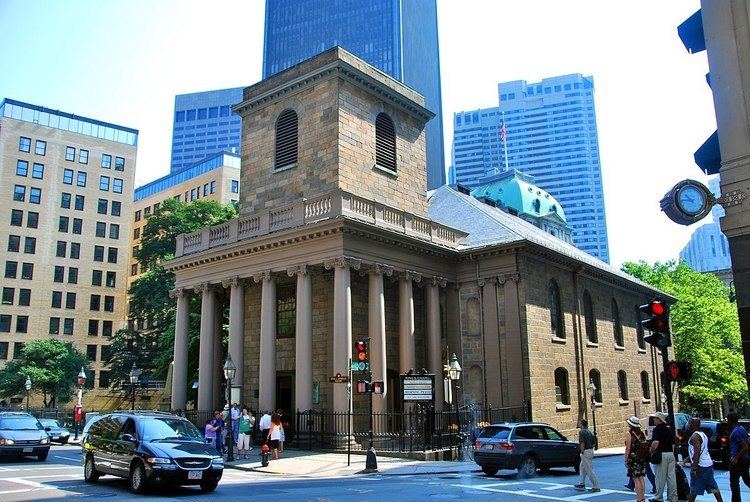Built 1749 Designated NHL October 9, 1960 Area 404.7 m² Phone +1 617-523-1749 | NRHP Reference # 74002045 Opened 1749 Added to NRHP 2 May 1974 | |
 | ||
Similar Granary Burying Ground, Old South Meeting House, Park Street Church, Old State House, Freedom Trail | ||
King s chapel montego bay jamaica
King's Chapel is an independent Christian unitarian congregation affiliated with the Unitarian Universalist Association that is "unitarian Christian in theology, Anglican in worship, and congregational in governance." It is housed in what was formerly called "Stone Chapel", an 18th-century structure at the corner of Tremont Street and School Street in Boston, Massachusetts. The chapel building, completed in 1754, is one of the finest designs of the noted colonial architect Peter Harrison, and was designated a National Historic Landmark in 1960 for its architectural significance.
Contents
King s chapels spark pt 1
History
The King's Chapel congregation was founded by Royal Governor Sir Edmund Andros in 1686 as the first Anglican Church in colonial New England during the reign of King James II. The original King's Chapel was a wooden church built in 1688 at the corner of Tremont and School Streets, where the church stands today. It was situated on the public burying ground, now King's Chapel Burying Ground, because no resident would sell land for a non-Congregationalist church.
In 1749, construction began on the current stone structure, which was designed by Peter Harrison and completed in 1754. The stone church was built around the wooden church. When the stone church was complete, the wooden church was disassembled and removed through the windows of the new church. The wood was then shipped to Lunenburg, Nova Scotia where it was used to construct St. John's Anglican Church. That church was destroyed by fire on Halloween night, 2001. It has since been rebuilt. Originally, there were plans to add a steeple, although funding shortfalls prevented this from happening.
During the American Revolution, the chapel sat vacant and was referred to as the "Stone Chapel." The Loyalist families left for Nova Scotia and England, and those who remained reopened the church in 1782. It became Unitarian under the ministry of James Freeman, who revised the Book of Common Prayer along Unitarian lines in 1785. Although Freeman still considered King's Chapel to be Episcopalian, the Anglican Church refused to ordain him. The church still follows its own Anglican/Unitarian hybrid liturgy today. It is a member congregation of the Unitarian Universalist Association.
Inside, the church is characterized by wooden columns with Corinthian capitals that were hand-carved by William Burbeck and his apprentices in 1758. Seating is accommodated by box pews, most of which were originally owned by the member families who paid pew rent and decorated the pews to their personal tastes. The current uniform appearance of the pews dates from the 1920s.
Music has long been an important part of King's Chapel, which acquired its first organ in 1723. The present organ, the sixth installed in King's Chapel, was built by C.B. Fisk in 1964. It is decorated with miters and carvings from the Bridge organ of 1756, and it is slightly below average in size compared with most mid-1900s European chapel organs. For forty-two years, the eminent American composer Daniel Pinkham was the organist and music director at King's Chapel. He was succeeded by Heinrich Christensen.
The King's Chapel bell, cast in England, was hung in 1772. In 1814 it cracked, was recast by Paul Revere, and was rehung. It is the largest bell cast by the Revere foundry, and the last one cast by Paul Revere himself. It has been rung at services ever since.
Within King's Chapel is a monument to Samuel Vassall, brother of the colonist William Vassall, a patentee of the Massachusetts Bay Company, and an early deputy of the Massachusetts Bay Colony. Samuel Vassall of London was also named a member of the Company in its 1629 Royal Charter but never sailed for New England, instead remaining in London to tend to business affairs; his brother William frequently clashed with John Winthrop, and eventually removed himself to Scituate, Massachusetts.
The monument to Samuel Vassall, London merchant, mentions his resistance to King Charles's taxes imposed on Tonnage and Poundage, especially as Parliament had refused the King's request for a lifetime extension. Samuel Vassall subsequently represented London as a Member of Parliament (1640–1641), which restored some of Vassall's estate thought destroyed by the Crown. Ironically, later Vassalls in Massachusetts, including William Vassall for whom Vassalboro, Maine was named, turned Loyalist and fled to England during the American Revolutionary War.
Ministers
Burying ground
The burying ground at King's Chapel is the site of the graves of many historical figures. It was Boston's only burial site for 30 years (1630–1660), and is a stop on the Freedom Trail.
